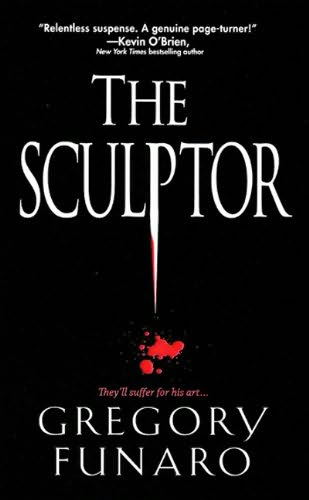It's not very often that I read thriller/crime type novels, especially when a psychotic serial killer is involved, but I'm really glad I picked up this book. (FYI, I get freaked out pretty easily and have spent most of life being convinced there is a murderer lurking around somewhere close. Reading these kinds of novels just reinforces that, but it's fun to fuel that fire ever now and then.)
In Gregory Funaro's debut novel, The Sculptor, art history professor Cathy Hildebrant finds herself being questioned a consultant in an FBI investigation of a series of murders. The murderer uses humans as "material" to construct insanely detailed reproductions of Michaelangelo's famous sculptures, even using epoxy and paint to make his victims look as if they are made of marble. As the area's foremost scholar on Michaelangelo and the author of a book on his work, Cathy is the obvious choice for helping authorities learn more about The Sculptor's inspiration. It becomes clear that The Sculptor is not only inspired by Michaelangelo, but also by Cathy's book. As the investigation continues, Cathy becomes more and more personally involved with the case, including being chosen to become one of the murderer's next sculptures.
I thoroughly enjoyed this book, and it was one of those stories that I didn't want to stop reading. The story keeps you turning the pages, and the idea of a serial killer modeling his victims as sculptures is pretty unique, at least when taken to the level that this psychopath takes it. Funaro also did his research for this book, which was pretty impressive. Since Cathy was supposed to be an expert on all things Michaelangelo, Funaro had to become an expert, too. I've learned plenty about Michaelangelo in all my years as a history student, but I learned a thing or two from this book. Books that are good and also teach you something -- what's better than that?
The point of view in this novel switches often -- from Cathy to various members of the FBI to the murderer's victims to the murderer himself. I thought it was really interesting that Funaro chose to have The Sculptor as one of the "narrators" of the novel, since that immediately tells the reader who he is. You don't spend the book guessing who it might be -- instead, you're taken into his head, following his thought processes on what victims to choose and why he chooses them, learning how he operates and what horrors he lived through as a child. When I first read a chapter that was in The Sculptor's point of view, I wasn't sure how I felt about it, since it took the mystery away, but as I read, I found that it added another element of suspense... You know who it is, and you know how close the FBI comes to him. Wondering when they will finally pick up on the right clue is what keeps you turning the pages. The only issue I had plot-wise was the inevitable love story... I guess it added some depth to the characters, but seriously, I don't need people to fall in love for me to enjoy a book.
As far as the writing goes, there are a few little things that bugged me here and there... The dialogue was a little unbelievable sometimes, especially coming from Cathy. The way she spoke sometimes sounded more like a prepared lecture she was giving at a conference than the sort of thing she would say of the top of her head while being questioned... I know she's supposed to be an expert and intellectual-type, but come on, no one talks like that, especially not when they're flustered and trying to piece things together bit by bit. Funaro also does this thing where he adds "Yes," or "No," to the beginning of statements of fact, and he does it a lot. Like, "Yes, the Sculptor was indeed pleased with his latest selection" or "No, Dr. Hildebrant couldn't let that happen, not again." Seems like a minor issue, but he uses it so often that I kind of found myself wanting to start counting "yes"es and "no"s.
But hey, for a first novel, I say A+. Great read.
4/5 stars
Read from March 7, 2011 to March 13, 2011
--C

No comments:
Post a Comment